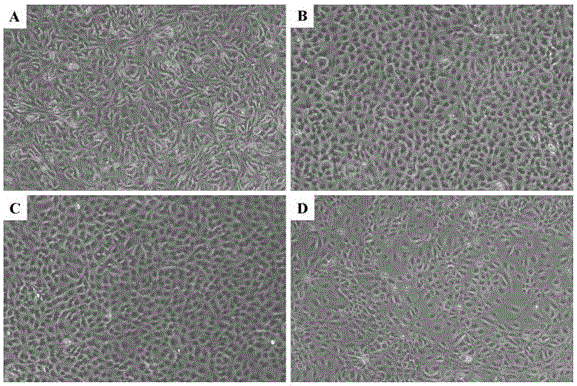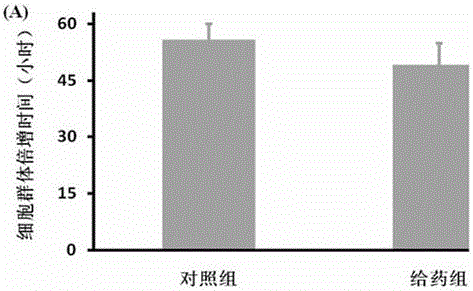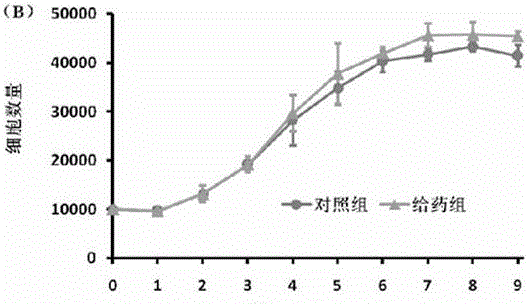Method for promoting in-vitro expansion of human amniotic epithelial cells and use thereof
An epithelial cell and in vitro expansion technology, applied in the field of stem cell biology, can solve the problems of large application risks, restrictions, and expensive cytokines, and achieve the effects of good safety, convenient operation, and increased cell ratio
- Summary
- Abstract
- Description
- Claims
- Application Information
AI Technical Summary
Problems solved by technology
Method used
Image
Examples
Embodiment 1
[0023] Example 1: Isolation, preparation, morphological and phenotypic characteristics of human amniotic epithelial cells
[0024] The amniotic membrane was aseptically stripped from the fresh placental tissue, washed repeatedly with the newly prepared D-Hank's solution containing double antibodies (final concentration of penicillin 100 U / mL, final concentration of streptomycin 0.1 mg / mL) to remove residual blood stains, and the amniotic membrane was cut into pieces. Add 0.05% trypsin digestion solution containing 0.02% EDTA, 37°C, 200 rpm rotary digestion for 10 min, discard the digestive solution, then add fresh digestion solution to the amnion tissue, 37°C, 200 rpm rotary digestion for 30 min, 300 mesh stainless steel The single cell suspension was collected by mesh filtration, and the digestion was terminated by adding medium containing 10% fetal bovine serum. Treated twice in the same way, combined the collected single cell suspension, centrifuged at 1500 rpm for 10 min, ...
Embodiment 2
[0026] Example 2: Effect of Nutritional Composition on Proliferation of Human Amniotic Epithelial Cells
[0027] Take P1 human amniotic epithelial cells in the logarithmic growth phase, digest and resuspend, and count the cells at 1.0×10 4 The cells / well were planted in a 96-well plate, and the medium was replaced after 48 h, and a control group and a nutritional composition group were set up (the dose of 300 kDa hyaluronic acid was 1 mg / mL concentration gradient, and the concentration of epidermal growth factor was 10 ng / mL, the concentration of vitamin C is 50 µg / mL, the concentration of GlutaMAX™-I supplement is 1% volume ratio factor, β -The concentration of mercaptoethanol is 1% volume ratio coefficient, the concentration of glycine is 7.5 mg / mL, the concentration of L-alanine is 8.9 mg / mL, the concentration of L-aspartic acid is 13.2 mg / mL, the concentration of L- The concentration of asparagine was 13.3 mg / mL, the concentration of L-glutamic acid was 14.7 mg / mL, the c...
Embodiment 3
[0034] Example 3: Effects of Nutritional Compositions on Human Amniotic Epithelial Cell Proliferation-Related Genes and Stemness Gene Transcription Levels
[0035] Take the P1 human amniotic epithelial cells in the logarithmic growth phase, and use 3×10 5 The cell density of cells / well was inoculated in 6-well plates, and the fresh medium was replaced after 3 days, and the control group and nutrition combination group (300 kDa hyaluronic acid 1 mg / mL) were set up, and the culture was continued for 48 h. Total RNA was extracted according to the kit instructions, and cDNA was synthesized by reverse transcription, that is, the concentration of total RNA in each group was uniformly adjusted to 50 ng / µL, and the reaction conditions were: 37°C, 15min; 85°C, 5s. The reverse transcription product (cDNA) was frozen and stored at -80°C for future use. Real-time fluorescence quantitative PCR, the reaction conditions are: 95°C, pre-denaturation for 30 s, then 40 cycles of PCR (denaturati...
PUM
 Login to View More
Login to View More Abstract
Description
Claims
Application Information
 Login to View More
Login to View More - R&D
- Intellectual Property
- Life Sciences
- Materials
- Tech Scout
- Unparalleled Data Quality
- Higher Quality Content
- 60% Fewer Hallucinations
Browse by: Latest US Patents, China's latest patents, Technical Efficacy Thesaurus, Application Domain, Technology Topic, Popular Technical Reports.
© 2025 PatSnap. All rights reserved.Legal|Privacy policy|Modern Slavery Act Transparency Statement|Sitemap|About US| Contact US: help@patsnap.com



